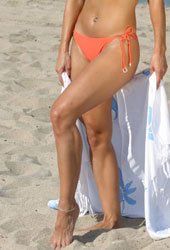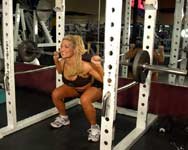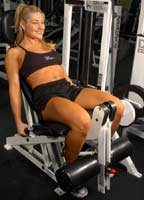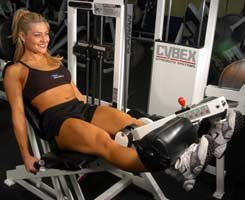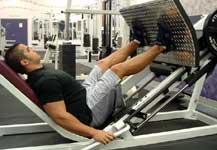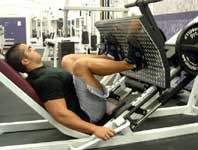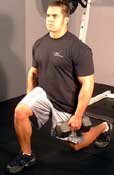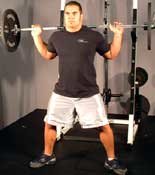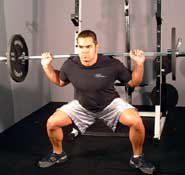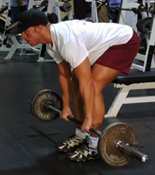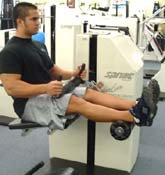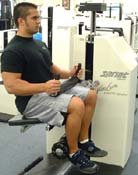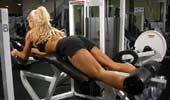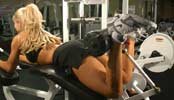Everyone loves a good pair of legs, and lucky for us, everyone has a set. What you do with them on a daily basis however will greatly affect how they look.
If your goal is to train your legs to develop massive amounts of muscle, you will train differently than someone whose goal is to lean down their legs and keep them streamlined and tight.
Many males who work out to build size are concerned with getting their backs huge and biceps bulging and often place too much emphasis on their arm workouts while neglecting to do anything for legs. This is one of the most detrimental mistakes any bodybuilder looking to build size can make.
Legs Articles:
- Training The Upper Legs! - By Jon Huston
- Work Those Legs - By Lisa Sutton
- Lisa's Lower Body Workout Program! - By Lisa Moser
- Other Legs Articles...
Benefits Of Leg Workouts
Because the legs contain such a massive amount of muscle tissue, when they are placed under an overloading stimulus they cause the release of anabolic hormones such as testosterone and growth hormone; much more than when you are working a smaller muscle such as your triceps.
These hormones alone stimulate muscle growth, so essentially, when you work your legs, you are indirectly helping the rest of you to grow as well. And besides, if you've ever seen one of these guys in the gym who only works their arms, a large upper body with chicken legs doesn't exactly look appealing.
Having strong legs is also important for anyone playing contact sports. Your legs are your base of support and provide you with the stability you need to stay standing when an opponent is trying to knock you down.
Strong legs help with everyday life too, as we will have an easier time walking up and down stairs, lifting heavy loads (since you should be lifting with your legs), and just being mobile in general.
Training To Increase Leg Size
In order to build good size on your legs, you will want to push your muscles to or almost to failure. You want to work them hard and then let them rest and grow.
It would be most appropriate for you to dedicate 1 or possibly 2 days, if you have good recovery ability, to your leg training. Your goal in this workout will be to lift heavy enough weights so that you can successfully complete 8 to 12 repetitions per set, while performing 2-4 sets per exercise.
| FORUM THREAD | |||
|
Started By: WannaBeCutGirl |
Your rest periods should last between 45 and 60 seconds. The objective of this length of rest is to give your muscles enough time to recover so you can lift heavy again, but not allow them to rest to long as this will decrease the amount of anabolic hormones you release.
Finally, depending on your individual experience and workload tolerance you may choose to include 2-5 different exercises per major muscle.
Keep in mind that some exercises will work more than one muscle, for example, lunges will work quads, hamstrings and glutes, whereas performing leg extensions primarily focuses on your quadriceps. To keep your legs responding, it is good to incorporate a variety of exercises into your training to keep your muscles guessing as to what comes next.
And, even though they are a relatively small muscle, you will want to include some calf work in your training, so choose a form of calf raises, either standing or sitting in your workout plan.
Quad Exercises
Barbell Squats
Single Barbell Leg Squats
Leg Extensions
Leg Press
Dumbbell Lunges
Sumo Squats
Hamstring Exercises
Stiff-Legged Barbell Deadlift
Hamstring Curls
Lying Hamstring Curls
Training Legs For Power
Now, some people will not be looking to add more muscle to their legs but will rather be hoping to increase the amount of power they can generate over a short period of time. This type of training will take into account a different rep/rest scheme than that of muscle hypertrophy (increase in size of muscle fiber).
Muscle Fiber Articles:
- Muscle Fibers: How Do They Differ? - By Shannon Clark
- Understanding Muscle Fiber Types. - By Kelly Baggett
- Other Muscle Fiber Articles...
If this is your goal, you will want to lift a heavier weight than if you were training for mass but will be performing only 4-8 reps per set. Your rest periods will also be longer as you want the muscle to fully recover and by allowing more time you decrease the chances of adding muscular bulk.
You may choose from the same list of exercises as above but may also want to include squat jumps, jumping lunges and sprinting exercises in your plan. These exercises will help target your fast twitch muscle fibers and get your motor units firing at a faster rate, thus helping you to generate more force per unit of time (thus greater power).
| FORUM THREAD | |||
|
Started By: beby24 |
Since this is very intense training, it should once again only be performed once or maybe twice a week, making sure that you take some good quality rest days in between your workouts.
Training For Lean Legs
Finally, some people out there, most commonly women, will wish to tone down their legs and keep them a little thinner and leaner while still showing some muscle development.
To accommodate this goal you would want to perform a greater number of reps with a lighter weight, taking the shortest rest breaks that you can handle. This workout would most likely closely resemble that of a circuit training one.
Circuit Training Articles:
- Circuit Training. - By Luis Berrios
- Circuit Training For Women. - By Sherry Gideons
- Other Circuit Training Articles...
You may wish to perform an exercise for your quads and then immediately move into one for your hamstrings and finish off with something for your calves and then repeat the cycle once again. By continually moving you will also be providing your body with an aerobic workout and will burn more calories during your training, thus helping to keep you lean.
You will want to work in the rep range of 15-20 reps and perform 3-5 sets per exercise. You can choose more exercises if you wish depending on how much other training you are currently doing and whether or not you are also performing additional cardio exercise.
Since you will be using a lighter weight and thus not stressing your muscles to complete failure, you will be able to include leg training 2-4 times a week, provided you are still taking at least one day off in between workouts. In addition to this training, performing cardio training such as running, uphill walking, or using an elliptical machine will help keep your legs trim and tight.
These types of cardio exercises do not provide a great deal of resistance (as much as biking would for example) and will thus help to lean your legs out without adding muscular bulk. You might try including a couple of days of interval training as well as this will help speed up your metabolism and allow you to burn more calories once you have finished your workout (a process known as EPOC - Excess Post-Exercise Oxygen Consumption).
 |
EPOC Excess post-exercise oxygen consumption (EPOC) is a measurably increased rate of oxygen intake following strenuous activity. The extra oxygen is used in the processes that restore the body to a resting state and adapt it to the exercise just performed. |
 |
 |
||
Conclusion
Whatever your goals are for your legs, a proper training program can help you accomplish them. Although similar exercises can be used for all types of objectives, it is the amount of reps per set, number of sets and exercises and amount of rest between sets you take that determines how your legs will look.

